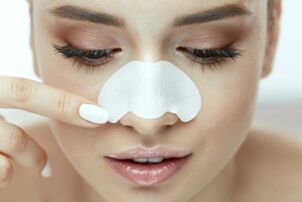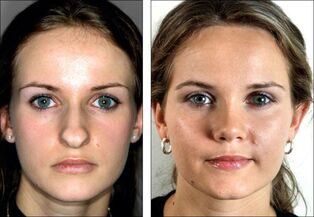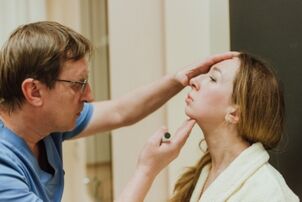Many have heard of classical surgery, but non-surgical rhinoplasty is a relatively new technique in medicine, and of course there are many questions about it. This article will be about the nuances of performing and rehabilitating non-surgical rhinoplasty. It will be especially helpful for those who experience complexes related to nasal defects but are not yet ready for surgery.
What is this and how does it happen?
Surgical correction of imperfections consists in the installation of special fillers or fibers to correct the shape of the nose and give symmetry.
This method can be used for those with minor defects that do not have breathing problems and a bent septum or nasal bone.
This method cannot be called a full-fledged alternative to surgery (with the exception of laser rhinoplasty), as some defects can only be corrected by classical rhinoplasty.

The differences between non-surgical and classical rhinoplasty are as follows:
- simplicity in execution, no long and painful rehabilitation period (here we described how rehabilitation is done with traditional rhinoplasty);
- execution speed;
- affordable cost;
- short duration of effect;
- Failure to resolve serious issues.
It should be noted that thisprocedure can be performed when the effect is weakened.
Plastic types without surgery
Non-surgical rhinoplasty can be of several types. The following describes in detail how each is made and how long the result lasts.
Injection
Rhinoplasty with fillers - injectable drugs used as fillers to correct defects caused by tissue deficiency.The procedure does not cause side effects,does not cause swelling and dissolves on its own within 1. 5 years.
The nasal area is treated with an antiseptic and then a filler is injected subcutaneously. The whole procedure takes about half an hour, after which the patient can go home.
Fillers can be:
- biodegradable- produced on the basis of biomaterials - hyaluronic acid, collagen;
- biodegradable- synthetic materials - silicone and so on;
- Autologous- the body's own adipose tissue.
Rhinoplasty for injection is also considered to be the administration of hormonal drugs. This procedure requires extreme care and precision, as failure to adhere to accurate dosing can exacerbate the situation.After the procedure, the effect is quite long,but complications can take the form of complications.
Laser
In this case, a laser is used instead of the scalpel required for plastic surgery, so the incisions are more gentle and the bleeding stops due to the cauterization of the blood vessels.
The surgical approach to laser surgery is not much different from classical rhinoplasty.
Using a laser simplifies the surgeon's task, not only can the operation itself be speeded up, but the rehabilitation period can also be shortened. Prior to surgery, the patient should be prepared, undergo examinations, and consult with a close specialist. With properly performed laser rhinoplasty, the result lasts for a long time.
Threads
Many plastic surgeons do not consider this type of rhinoplasty to be effective, so it is not common. Fibers are most commonly used to correct the shape of the tip or wings of the nose (here you can read about techniques for traditional rhinoplasty of the wings, tip, and other parts of the nose). The specialist will make small punctures when inserting the fibers. The skin and tissues are fastened with artificial material. The effect lasts a long time.
Fallen
The langette is a special tool that looks like a plastic clothespin. It is designed to be worn for several hours a day to change the shape of the cartilage tissue. However, it takes several months to acquire the accentuated effect. You can fix minor bugs:
- returns to nose symmetry;
- straighten a small hump;
- lift the tip of the nose (learn how to solve problems with the tip of the nose with a special material using classic rhinoplasty);
- reduce the width of the wings.
Before and after photos
We then recommend that you familiarize yourself with photos of patients before and after rhinoplasty that were taken without surgery.

Readings
Rhinoplasty for injection is performed in the following cases:
- hump at the back of the nose;
- flat top back;
- nasal asymmetry;
- dips and valleys;
- drooping nasal tip; nose angle
- ; The need for
- correction after surgical rhinoplasty.
The indications for laser rhinoplasty are as follows:
- change the length of the nose;
- nasal bridge too wide;
- non-aesthetic nose back;
- wide or narrow mountain; the nostrils of
- are too wide or narrow;
- wing correction.
This procedure has functional indications:
- nasal injury with bone or cartilage fracture;
- congenital curvature of the back of the nose, which impairs the passage of air;
- cartilage base error.
Contraindications
Several contraindications:
- presence of oncological disease;
- prone to allergic reactions - possible allergy to fillers injected under the skin;
- pregnancy and lactation;
- early childhood - children’s cartilage is not fully formed and premature correction may lead to worsening of the situation in the future;
- It is not recommended to perform procedures during menstruation.
Why is this technique dangerous?
Although non-surgical rhinoplasty has a very small effect on the condition of the body as a whole, it can lead to undesirable consequences:
- Improper insertion of the filler under the skin can cause the helium nodules to move sideways over time and the resulting shape to change.
- There is a risk of infection and infection.
- Swelling and bruising occur immediately after the procedure, but in most cases these effects go away within a few days without treatment.
- After an unsuccessful procedure, it is impossible to change the shape of the nose immediately, as the drugs administered are persistent and their splitting only begins after a few months.
Other complications include:
- pain;
- redness;
- embolic changes in blood vessels;
- fibrotic changes at the injection site;
- allergy;
- whitish accumulations in adjacent injection zones.
Complications can be short-term or long-term; if your appearance or well-being deteriorates permanently, consult a specialist.
Most often, after non-surgical rhinoplasty, various complications occur when the procedure is performed by a low-skilled doctor or in non-specialized salons.
In order to protect yourself from such inactive phenomena, you must approach the clinic and the doctor in charge of the procedure responsibly and, if necessary, be properly prepared for the procedure. In addition, the doctor should be informed in advance about existing diseases, including chronic diseases, as the choice of technique depends on this.
Here we talked about the consequences that patients can expect after classical rhinoplasty and how to avoid it.
Rehabilitation

A feature of non-surgical rhinoplasty is that it has a short rehabilitation period. It takes an average of 1-2 days for all the bruises and hematomas to pass. Tissue swelling may persist for up to 5 days, and to reduce it more quickly, ice compaction should be applied to the site of exposure in the first hours after the procedure to prevent the spread of edema.
Summary table
| Fillers |
|
|
| Hormonal injections |
|
|
| Laser |
|
|
| Threads |
|
|
| Langette |
|
|
Dissatisfaction with one's own appearance is often the cause of human complexes, depression, and psychosis. But sometimes it’s enough to just pull up the tip of your nose a little, so life shines in bright colors and self-confidence appears.
But not all people, even those very dissatisfied with their appearance, can afford classic rhinoplasty - some are frightened by the price, others are afraid of complications and unsuccessful surgeries, and some fear a long time of rehabilitation. In this case, it makes sense to think of non-surgical rhinoplasty, which, while not a complete alternative to surgery, can easily cope with certain disadvantages.






















